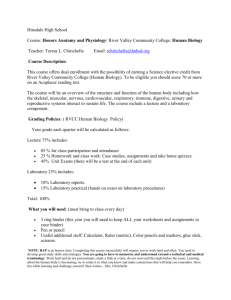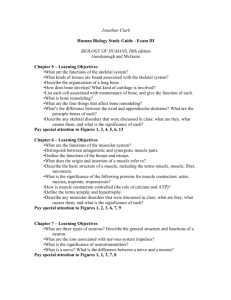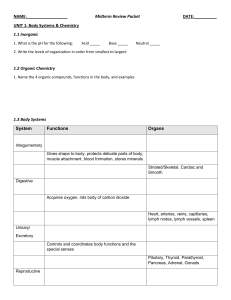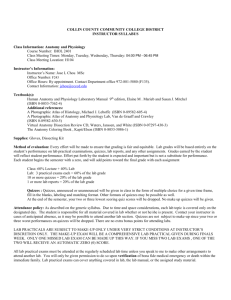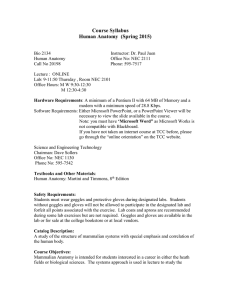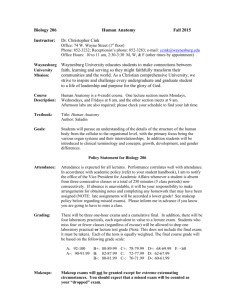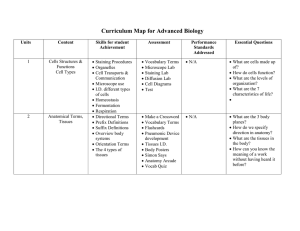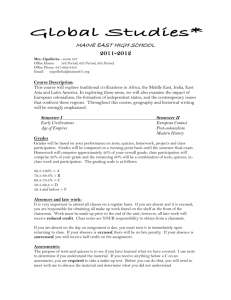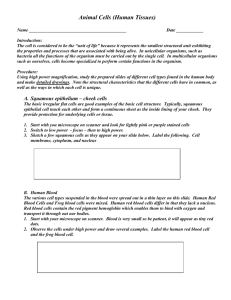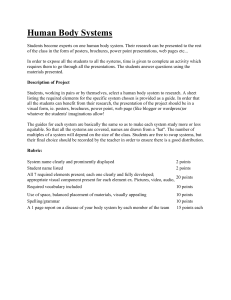Anatomy and Disease Syllabus Fall 2013 Diana B. Callison Email
advertisement
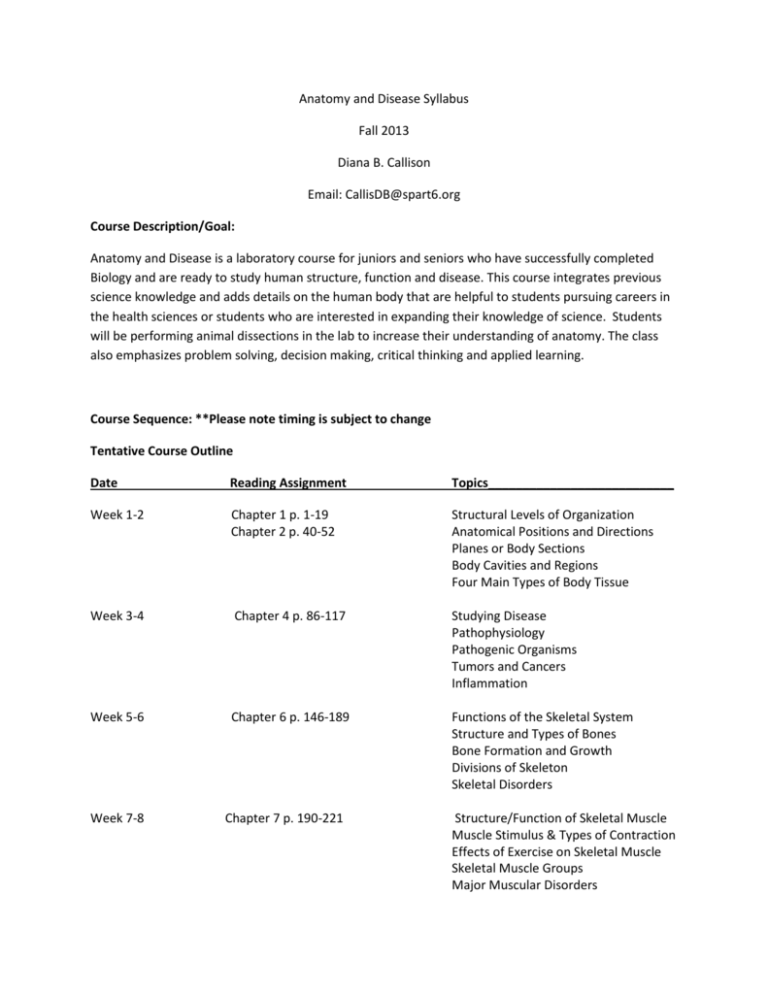
Anatomy and Disease Syllabus Fall 2013 Diana B. Callison Email: CallisDB@spart6.org Course Description/Goal: Anatomy and Disease is a laboratory course for juniors and seniors who have successfully completed Biology and are ready to study human structure, function and disease. This course integrates previous science knowledge and adds details on the human body that are helpful to students pursuing careers in the health sciences or students who are interested in expanding their knowledge of science. Students will be performing animal dissections in the lab to increase their understanding of anatomy. The class also emphasizes problem solving, decision making, critical thinking and applied learning. Course Sequence: **Please note timing is subject to change Tentative Course Outline Date Reading Assignment Topics___________________________ Week 1-2 Chapter 1 p. 1-19 Chapter 2 p. 40-52 Structural Levels of Organization Anatomical Positions and Directions Planes or Body Sections Body Cavities and Regions Four Main Types of Body Tissue Week 3-4 Chapter 4 p. 86-117 Studying Disease Pathophysiology Pathogenic Organisms Tumors and Cancers Inflammation Week 5-6 Chapter 6 p. 146-189 Functions of the Skeletal System Structure and Types of Bones Bone Formation and Growth Divisions of Skeleton Skeletal Disorders Week 7-8 Chapter 7 p. 190-221 Structure/Function of Skeletal Muscle Muscle Stimulus & Types of Contraction Effects of Exercise on Skeletal Muscle Skeletal Muscle Groups Major Muscular Disorders Week 9-10 Chapter 8 p. 222-269 Organs and Cells of the Nervous System Nerves, Reflex Arcs and Nerve Impulses Central Nervous System Peripheral Nervous System Autonomic Nervous System Week 11-12 Chapter 12 p. 358-381 Chapter 13 p. 383-385, 396-400 Anatomy of the Heart Blood Flow through the Heart Coronary Heart Disease Cardiac Cycle and Heart Failure Conduction System of the Heart Blood Vessels and Pressure Week 13 Chapter 15 p. 436-465 Structures of the Respiratory System Respiration and Its Regulation Disorders of the Respiratory Tract Week 14-15 Chapter 16 p. 474-509 Structures of the Digestive Tract Disorders of the Digestive Tract Peritoneum Digestion and Absorption Week 16-17 Chapter 18 p. 530-555 Kidneys Formation of Urine Ureters and Urinary Bladder Renal and Urinary Disorders Week 18 Dissection & Exam Dissection of Mink Review for Comprehensive Final Exam Final Exam Textbook: The Human Body in Health and Disease by Thibodeau and Patton (Estimated Replacement Cost is $75) Materials Required for Class: 1. Spiral notebook (provided for you) 2. 1’’ or 1.5’’ 3-ring binder 3. Colored Pencils (24 minimum) Evaluation: Assessments will be given in the form of tests, quizzes, projects, daily work, homework, notebook and journal quizzes, and class participation. Tests will be given at the end of each unit and quizzes will be given between tests. Quizzes may be unannounced. Class participation, INCLUDING DISSECTION, is essential for success. End of Course Test or Final Exam Grade: The Final Exam will be comprehensive and given the final week. It will be worth 10% of the final grade in the course. Grades: Quarter Grades: Tests………………………………..………………….40% Quizzes…………………………..……………………20% Daily (HW and class participation)……….20% Labs and Projects…………………………………20% Final Grades: Quarter grades……………………………………..90% Final Exam……………………………………………..10% Makeup Policy: It is each student’s responsibility to make up missed assignments. Students have FIVE days to complete missed work, even TESTS. If a student fails to turn in missing assignments and/or make up a lab or test within that 5 day period, a zero will be given and there will be no opportunity to make up the grade. The teacher will work with students having extenuating circumstances. Class Rules: ALL rules in the student handbook will be followed. Consequences: First Offense: Warning Second Offense: Detention and Parent Contact Third Offense: Discipline Referral and Parent Contact
